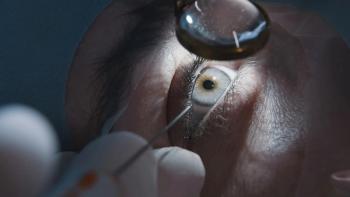
Optical coherence tomography useful for detecting, managing retinal disease
Optical coherence tomography may be useful in identifying and monitoring retinal changes or retinal diseases that may be invisible to ophthalmoscopy in patients with diabetic retinopathy, AMD, retinitis pigmentosa, hydroxychloroquine toxicity, and high myopia.
"Among all instruments, the OCT generated the most interest and comments among optometrists, according to [an annual diagnostic technology survey], which was based on responses from 228 optometrists to an email questionnaire," began Dr. Bittner, Lions Vision Research and Rehabilitation Center, Johns Hopkins University School of Medicine, Baltimore.
When using an OCT, it is important to know what is normal and what is abnormal, she continued.
Second, check that the automated algorithm correctly identified the borders for the retinal thickness measurement. If it does not, that correction must be made manually, she added. Finally, you should consider the pathology.
Diabetic retinopathy
In diagnosing diabetic macular edema (DME), there is excellent agreement between OCT-graded foveal thickening and ophthalmo-scopic assessment when foveal thickness was judged normal, or moderately to severely increased. Agreement, however, substantially decreased when foveal thickness was only mildly increased.1-2
"OCT is the single most important diagnostic and prognostic indicator for DME, and in some cases, may be more sensitive to the presence of edema than clinical exam," she said. "At the extremes, there was very good agreement between OCT retinal thickness and clinical exam. But it's those in-between cases in which the OCT can be very helpful and pick up mild edema," she added.
As many as 15% of eyes with severe non-proliferative or proliferative retinopathy without DME on clinical examination had OCT-detectable DME.3
Comparison studies
In a meta-analysis of six studies to determine the usefulness of OCT images in diagnosing DME, researchers compared fundus photography, biomicroscopy, and OCT measurement correlations in DME.4 OCT compared well to both biomicroscopy and fundus photography in this analysis, with relatively good sensitivity and specificity. OCT also offers the advantage of a quantitative evaluation of DME for monitoring progression over time.
The Diabetic Retinopathy Clinical Research Network found only a moderate correlation between time-domain OCT and visual acuity (VA).5 Central retinal thickness accounted for only up to 27% of variability in concurrently measured VA. Overall, they found that for every 100-µm decrease in central retinal thickness after DME was treated with laser, VA improved by 4.4 letters on average.
There was, however, a paradoxical worsening in VA with a decrease in OCT central thickness in 18% to 26% of the study cohort over 12 months. There also was a paradoxical VA improvement with increases in OCT central thickness in 7% to 17% of the cohort over 12 months.5
"Change in central thickness measured by time-domain OCT is not necessarily a reliable indicator of VA outcomes. It is possible that with spectral domain-OCT, these correlations may improve; however, we need a large study to determine that," Dr. Bittner said.
Researchers prospectively followed a co-hort of type-2 diabetics for 4 months after treatment with focal macular photocoag-ulation.6 SD-OCT images showed distinct hyperrelective foci distributed throughout multiple layers of the retina. These were detected by SD-OCT but not by biomicroscopy. With a decrease in retinal thickness post-photocoagulation, the dots either resolved completely, or finally formed oph-thalmoscopically detectable hard exudates during extended follow-up.
Newsletter
Want more insights like this? Subscribe to Optometry Times and get clinical pearls and practice tips delivered straight to your inbox.













































